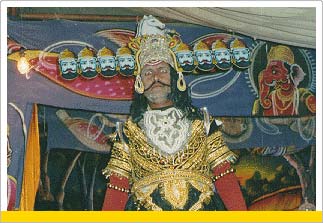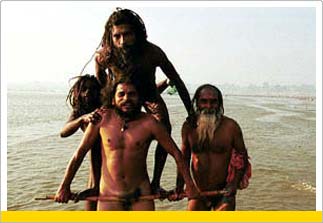| Home >> Fairs and Festivals | ||||||
| Fairs and Festivals in India | ||||||
| ||||||
 India does not need an occasion to celebrate since every day is a celebration of sorts in the country. Whether it is a change of season, a good harvest, a religious occasion or even a national event, there is always a reason to celebrate in India. And each occasion is a part of the fabric that is India's culture. To put it simply, the festivals and fairs on offer in the country are mind-boggling and in most cases a fascinating experience. Whether it is Holi, the festival of colours or Deepawali, the festival of lights, there is joy and happiness all around. The festivities bring with them a wide array of colours, sights, smells and sounds; all of them so intrinsically Indian that you will want to preserve it in your memory like a pleasant dream. India's fairs are best experienced in the villages since that is where the joy and happiness is more spontaneous and forthcoming. Each of the festivals - from the local cattle fairs and the national handicrafts mela to the country's Independence Day celebrations on August 15 every year - provide the tourist with a ringside view of the rich cultural heritage of India. Durga Puja Where: Eastern India, specially West Bengal Durga Puja is a time for festivity in eastern India, especially in West Bengal. Though the festival is celebrated all over India, it is known by many names, one of them being Navratri. The Puja or worship of Goddess Durga, the ten-armed goddess of fertility, is usually in autumn during the months of September or October. Around this time of the year, the weather is perfect - neither hot nor cold but pleasant enough -- for the festive season. The festive period begins with Mahalaya, a day when people remember their ancestors and pray for their well-being. A week later, the Durga Puja starts with Kolkata and West Bengal in total holiday mode. There are gaily-decorated Puja pandals everywhere, full of light and glitter and hordes of devotees in their new clothes, all vying to have a glimpse of Mother Durga. The worship starts on the day of Sashti or the sixth day and goes on till Dashami or the tenth day when the Mother Goddess is believed to go back to her husband's home. Women bid her a tearful farewell with candles, fruits and saris. 
The legend that is commonly associated with the Durga Puja is one in which Mahishasura, a demon, received a boon from Lord Shiva, which made him virtually invincible. He could be killed by no man or or God would be able to kill him. Emboldened by that boon, Mahishasura went on a rampage killing people and troubling the Gods. The Gods then appealed to Shiva to stop Mahishasura. Angry Shiva created a powerful woman and the gods helped by giving her their energy and a weapon each. She rode a lion and beheaded Mahishasura. Durga Puja or Navratri is observed everywhere in the country and in western India, youngsters take part in community dancing of Dandiya and Garba. To have a ringside view of the Durga Puja celebrations, you must take a trip to India's City of Joy, Kolkata. Dussehra Where: Throughout India As Christmas is to the West, Dussehra is to India. The festival marks the beginning of the pleasant winter season after the searing heat of summer. Like other festivals of its kind, Dussehra too marks the victory of good over evil. All over north India, gigantic effigies of the ten-headed Ravana and his brothers are set aflame amidst bursting of crackers. Dussehra is also the time for fairs where people gather to buy, enjoy and eat.
One of the most prominent Hindu festivals, Dussehra commemorates Lord Ram's triumph over Ravana. In Delhi, tableaux about Ram's life is taken out in processions on the streets during Dussehra and on the tenth day Vijayadashami or the day of victory gigantic paper effigies of Ravana, his brother Kumbhkarna and son Meghnad are put up for the Ram Lila, the epic story about Ram. Actors dressed as Ram and his brother Lakshman arrive and shoot flaming arrows at the effigies. The effigies and the firecrackers in them burst with a deafening sound amidst cheers from the watching crowds.
It is just before Dussehra that Navratri or the nine days of the worship of Goddess Durga is performed.
While the celebrations in Delhi and other parts of north India are worth experiencing, it is in Kullu, a small town in Himachal Pradesh, that Dussehra celebrations are unique. The celebrations begin three days after they do in the rest of India.
In south India, the first three days are dedicated to the worship of Goddess Lakshmi symbolising wealth and prosperity, the next three days to Goddess Saraswati depicting knowledge and the last three days to Goddess Durga symbolizing power. In Mysore, for example, Dussehra is celebrated with pomp and pageantry reminiscent of medieval times. And, in eastern India, Dussehra is Durga Puja, a celebration for nine days.
Kumbh Mela Where: Nasik, Ujjain, Haridwar, Allahabad The Kumbh Mela is held once every three years by rotation, in Nasik on the banks of the Godavari, in Ujjain on the banks of the Shipra, in Haridwar on the banks of the Ganga and in Allahabad at the confluence of the Ganga, Yamuna and the mythical Saraswati. The mother of all fairs comes every 12 years at Allahabad during the Purna Kumbh or Maha Kumbh. That is the biggest and most auspicious fair. The last Maha Kumbh was held in 2001. The Ardh Kumbh follows the Maha Kumbh and is celebrated every six years at Allahabad. The Kumbh Mela sees millions of Hindus congregating on the river banks for a bath to gain spiritual salvation. Perhaps, the other more important part of the Kumbh, is the gathering of holy men, sadhus or ascetics. The main ritual at the Kumbhs are the baths on the day of the new moon. Hindus believe that a bath in the sacred rivers can cleanse them of their sins and free them from rebirth. The origin of the congregations for the Kumbh can be found in the ancient epics of India like the Mahabharat and the Ramayan. The story goes that the gods wanted to become immortal and approached Vishnu, the preserver of the universe. Vishnu directed them to the ocean where the secrets of life and death were hidden. The gods with the help of the demons churned the ocean till Dhanvantari, the divine physician, came out holding a pitcher or Kumbh of Amrit (the nectar of life) that could bring immortality. As both the demons and the gods jumped for the nectar, Dhanvantari became a bird and flew away to the heavens. In the course of his 12-day long journey, the physician rested at Prayag, Nasik, Ujjain and Haridwar. These places are now the holiest of places for Hindus. The Kumbh Mela's importance has been growing over the years and today millions of pilgrims - poor and rich -- from all over the world, gather for the once-in-a-lifetime experience. Others who are not too religious minded come to see the magic of India, the crowds and holiness all around. | ||||||
| ||||||
 With most of the country celebrating Dussehra, no specific place can be left out of your itinerary. Almost every part of the country has its own specific way of celebrating the victory of good over evil.
With most of the country celebrating Dussehra, no specific place can be left out of your itinerary. Almost every part of the country has its own specific way of celebrating the victory of good over evil.